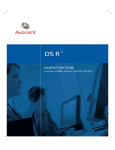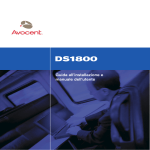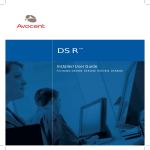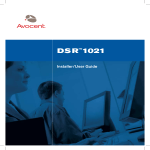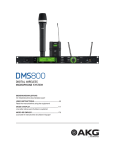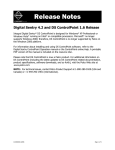Download Avocent DSR1161 User guide
Transcript
DSR Installer/User Guide For models: DSR800 DSR1161 DSR2161 DSR4160 INSTRUCTIONS This symbol is intended to alert the user to the presence of important operating and maintenance (servicing) instructions in the literature accompanying the appliance. DANGEROUS VOLTAGE This symbol is intended to alert the user to the presence of uninsulated dangerous voltage within the product’s enclosure that may be of sufficient magnitude to constitute a risk of electric shock to persons. POWER ON This symbol indicates the principal on/off switch is in the on position. POWER OFF This symbol indicates the principal on/off switch is in the off position. PROTECTIVE GROUNDING TERMINAL This symbol indicates a terminal which must be connected to earth ground prior to making any other connections to the equipment. DSR Installer/User Guide Avocent, the Avocent logo and The Power of Being There are trademarks of Avocent Corporation. OSCAR is a registered trademark of Apex Inc. All other marks are trademarks or registered trademarks of their respective owners. © 2003 Avocent Corporation. All rights reserved. USA Notification Warning: Changes or modifications to this unit not expressly approved by the party responsible for compliance could void the user's authority to operate the equipment. Note: This equipment has been tested and found to comply with the limits for a Class A digital device, pursuant to Part 15 of the FCC Rules. These limits are designed to provide reasonable protection against harmful interference when the equipment is operated in a commercial environment. This equipment generates, uses and can radiate radio frequency energy and, if not installed and used in accordance with the instruction manual, may cause harmful interference to radio communications. Operation of this equipment in a residential area is likely to cause harmful interference in which case the user will be required to correct the interference at his own expense. Canadian Notification This digital apparatus does not exceed the Class A limits for radio noise emissions from digital apparatus set out in the Radio Interference Regulations of the Canadian Department of Communications. Le présent appareil numérique n’émet pas de bruits radioélectriques dépassant les limites applicables aux appareils numériques de la classe A prescrites dans le Règlement sur le brouillage radioélectrique édicté par le Ministère des Communications du Canada. Japanese Approvals Agency Approvals UL 1950, CSA C22. 2 No. 950, EN60950, IEC 950 FCC part 15A, EN55022, EN50082 Republic of Korea EMI Standard Certificate Number: E-F900-01-2012 (A) Table of Contents Chapter 1: Product Overview Features and Benefits . . . . . . . . . . . . . . . . . . . . . . . . . 3 Safety Precautions . . . . . . . . . . . . . . . . . . . . . . . . . . . 5 Chapter 2: Installation Getting Started . . . . . . . . . . . . . . . . . . . . . . . . . . . . . . 9 Installing the DSR Unit . . . . . . . . . . . . . . . . . . . . . . 11 Chapter 3: Local Port Operation Controlling your System at the Local Port . . . . . . 17 Viewing and Selecting Ports and Servers . . . . . . . . 17 Configuring OSCAR . . . . . . . . . . . . . . . . . . . . . . . . 20 Resetting your Keyboard and Mouse . . . . . . . . . . . 26 Displaying Version Information . . . . . . . . . . . . . . . 27 Chapter 4: Terminal Operations Accessing the Terminal Menu . . . . . . . . . . . . . . . . . 31 Appendices Appendix A: FLASH Upgrades . . . . . . . . . . . . . . . . 37 Appendix B: Technical Specifications . . . . . . . . . . 38 Appendix C: Technical Support . . . . . . . . . . . . . . . 39 1 Product Overview Contents Features and Benefits . . . . . . . . . . . . . . . . . . . . . . . . 3 Safety Precautions . . . . . . . . . . . . . . . . . . . . . . . . . . . 5 Chapter 1: Product Overview 3 Chapter 1: Product Overview Features and Benefits Avocent’s DSR combines analog and digital technology to provide flexible, centralized control of data center servers. This solution provides enterprise customers with a significant reduction of cable volume, secure remote access and flexible server management from anywhere at anytime. The DSR consists of a rack mountable KVM switch configurable for analog or digital connectivity. Each DSR model provides enhanced video quality of up to 1280 x 1024 for digital users and 1600 x 1280 for the analog user. The DSR works over standard LAN connections. Users can access servers across a 100BaseT Ethernet connection or directly through a local port on the DSR for digital KVM and administration, depending on the model selected. The IP-based DSR appliance gives you flexible server management control from anywhere in the world. Reduce cable bulk With server densities ever increasing, cable bulk remains one of the major concerns of every network administrator. The DSR significantly relieves KVM cable volume in the rack by utilizing the innovative DSRIQ module and single CAT 5 cabling. This allows you higher server density while providing greater airflow and cooling capacity. The DSRIQ module is powered directly from the server and provides Keep-alive functionality whether or not the DSR unit is powered up. Access the DSR via network connection No special software or drivers are required on the attached, or Host, computers. Users access the DSR unit and all attached systems via Ethernet from a PC running the DSView application. This software resides on the user PC. User PCs can be located anywhere a valid network connection exists. The DSR unit can be configured on a separate network from your data network, allowing access to your servers even if your applications network is down. DSView provides simple point and click access to any server When a user connects, the DSView application will display a listing of all computers and serial devices to which the user has permission to access. When a user selects a computer from the list, the video of the selected computer is displayed in the program window. Multiple servers can be accessed by one user. Each additional computer’s video will appear in a separate program window. 4 DSR Installer/User Guide DSAdmin and DSAuthentication Service create and manage user permissions with DES encrypted security An administrator describes the configuration of computers attached to the DSR using an application called DSAdmin. Once the topology is described, the administrator then establishes which computers a user has permission to access. Usernames and passwords are derived from Windows NT, eliminating the need for redundant user databases. Once the topology is established, the DSAuthentication Service software manages the system’s user permissioning. DSView polls the server for access permissions on power-up and every time a switch is initiated for the most current permissions possible. A refresh is also available for immediate updates to a user’s access profile. In addition to the permissioning function, the DSAuthentication Service also stores pertinent information about attached devices in a database. Room location, rack location and computer type can all be stored for quick reference. CAT5 Connection KVM-Connection to Switch Digital IP-connection DSR2161 TCP/IP Analog User Figure 1.1: Example DSR Configuration Digital User Chapter 1: Product Overview 5 Number of Digital Analog servers users user DSR 800 8 1 1 16 1 1 16 2 1 16 4 0 DSR 1161 100-240V , 1.0A, 50-60 Hz LAN 1 2 3 4 5 6 7 8 9 10 11 12 13 14 15 16 DSR 2161 100-240V , 1.0A, 50-60 Hz LAN 1 2 3 4 5 6 7 8 9 10 11 12 13 14 15 16 1 2 3 4 5 6 7 8 9 10 11 12 13 14 15 16 DSR 4160 100-240V , 1.0A, 50-60 Hz LAN Figure 1.2: DSR Model Comparison Safety Precautions To avoid potential video and/or keyboard problems when using Avocent products: • If the building has 3-phase AC power, ensure that the computer and monitor are on the same phase . For best results, they should be on the same circuit. • Use only Avocent-supplied cable to connect computers and KVM switches. Avocent warranties do not apply to damage resulting from user-supplied cable. To avoid potentially fatal shock hazard and possible damage to equipment, please observe the following precautions: • Do not use a 2-wire power cord in any Avocent product configuration. • Test AC outlets at computer and monitor for proper polarity and grounding. • Use only with grounded outlets at both the computer and monitor. When using a backup power supply (UPS), power the computer, the monitor and the DSR unit off the supply. NOTE : The AC inlet is the main disconnect. 6 DSR Installer/User Guide Rack mount safety considerations • Elevated Ambient Temperature: If installed in a closed rack assembly, the operation temperature of the rack environment may be greater than room ambient. Use care not to exceed the rated maximum ambient temperature of the unit. • Reduced Air Flow: Installation of the equipment in a rack should be such that the amount of airflow required for safe operation of the equipment is not compromised. • Mechanical Loading: Mounting of the equipment in the rack should be such that a hazardous condition is not achieved due to uneven mechanical loading. • Circuit Overloading: Consideration should be given to the connection of the equipment to the supply circuit and the effect that overloading of circuits might have on overcurrent protection and supply wiring. Consider equipment nameplate ratings for maximum current. • Reliable Earthing: Reliable earthing of rack-mounted equipment should be maintained. Pay particular attention to supply connections other than direct connections to the branch circuit (e.g. use of power strips). 2 Installation Contents Getting Started . . . . . . . . . . . . . . . . . . . . . . . . . . . . . . 9 Installing the DSR Unit . . . . . . . . . . . . . . . . . . . . . . 11 Chapter 2: Installation 9 Chapter 2: Installation The DSR system requires that the DSView, DSAdmin and DSAuthentication Service software be installed prior to use. DSView is the application that allows a user to view and control a server attached to the DSR system. DSAdmin is used to configure and maintain the system. DSAuthentication is a Windows NT or 2000 service used to prevent unauthorized access to the DSR system. NOTE : The local port, on models DSR800, DSR1161 and DSR2161, does not require the DS software for operation. The local port uses OSCAR, Avocent’s on-screen configuration and activity reporting interface. For more information, see Chapter 5. The DSR system uses Ethernet networking infrastructure and TCP/IP protocol to transmit keyboard, video and mouse information between operators and connected computers. Although 10BaseT Ethernet may be used, Avocent recommends a dedicated, switched 100BaseT network. Getting Started Before installing your DSR, refer to the list below to ensure you have all items that shipped with the DSR as well as other items necessary for proper installation. Supplied with the DSR • DSR Unit • Local country power cord • Rack mounting brackets • Null modem cable • DSR Installer/User Guide • DSR Quick Install Additional items needed • One DSRIQ module per server • One CAT 5 patch cable per server (up to 10 meters) • DS Software Verification of Ethernet/computer connections The front panel of the DSR features two LEDs describing the Ethernet connection. The top LED is the Link indicator. It will illuminate when a valid connection to the network is established and blink when there is activity on the port. The lower amber LED, labeled 100Mbps, will indicate that you are communicating at the 100Mb rate. Additionally, there are two LEDs above each port number on the front of your unit: one green and one amber. The green LED will illuminate when the 10 DSR Installer/User Guide attached system is powered-on. The amber LED will illuminate when that port is selected by the DSView Client. Setting up your network The DSR system uses IP addresses to uniquely identify the DSAuthentication Server, the DSR units and the computers running DSView. The DSR supports both bootP (a subset of DHCP) and Static IP addressing. Avocent recommends that IP addresses be reserved for each unit and that they remain static while the DSR units are connected to the network. For additional information on how the DSR uses the TCP protocol, see Appendix D. CAT5 Connection KVM-Connection to Switch Digital IP-connection th Au DS DSR2161 Authentication Service TCP/IP Analog User Figure 2.1: The DSR in a Network Configuration Digital User 11 Chapter 2: Installation Installing the DSR Unit The diagram below illustrates one possible configuration for your DSR appliance. Follow the lettered and numbered instructions below to successfully install your DSR unit. The figure below illustrates one possible configuration. Network Digital User Configuration Port for updating firmware DSR1161 Appliance 100-240V , 1.0A, 50-60 Hz 1 2 LAN 3 4 5 6 7 8 9 10 11 12 13 14 15 16 Servers 2-16 Analog User DSRIQ Module Server 1 Figure 2.2: Basic DSR Configuration WARNING: To reduce the risk of electric shock or damage to your equipment- Do not disable the power cord grounding plug. The grounding plug is an important safety feature. - Plug the power cord into a grounded (earthed) outlet that is easily accessible at all times. - Disconnect the power from the unit by unplugging the power cord from either the electrical outlet or the unit. 12 DSR Installer/User Guide To install the DSR hardware: 1. Remove the DSR unit from the packing material. 2. Connect a terminal or PC running terminal emulation software (such as HyperTerminal) to the Configuration Port on the back panel of the DSR using the supplied null-modem cable. The terminal should be set to 9600 baud, 8 bits, 1 stop bit, no parity, no flow control. 3. Plug the supplied power cord into the back of the DSR unit and then into an appropriate power source. 4. When the power is switched on, the Power indicator on the front of the unit will blink for approximately 30 seconds while performing a self-test. Approximately 10 seconds after it stops blinking, press the Enter key to access the main menu. NOTE: The DSR unit may be rack mounted in a 1U configuration. The DSR does not support a 0U configuration. To configure the DSR hardware: 1. You will see the Terminal Applications menu with six options. Select option 1, Network Configuration. Figure 2.3: Network Configuration Menu 2. Select option 1 to set your network speed. When possible, you should set your connection manually without relying on the auto negotiate feature. Once you enter your selection, you will be returned to the Network Configuration menu. 3. Select option 2 and specify if you are using a static or BootP IP address. Avocent recommends using a static IP address for ease of configuration. If you are using a BootP address, please configure your BootP server to provide an IP address to the DSR, and skip to procedure C. Chapter 2: Installation 4. 13 Select options 3-5 from the Terminal application menu in turn to finish configuring your DSR for IP Address, Netmask and Default Gateway. Once this is completed, type a Ø to return to the Main menu. To adjust the mouse acceleration: NOTE: We highly recommend that all Windows systems attached to the DSR use the default Windows PS/2 mouse driver. Before a PC running Windows NT or 2000 can be connected to the DSR, an adjustment to mouse acceleration must be made. Follow the steps below. For Windows NT (using default drivers): 1. From the Desktop, select Start - Settings - Control Panel – Mouse. 2. Click on the Motion tab. 3. Set the pointer speed to Slow. This will also need to be done for any NT user account that will be accessing the NT system through the DSR. For Windows 2000: 1. From the Desktop, select Start - Settings - Control Panel - Mouse. 2. Click on the Motion tab. 3. Set the Acceleration setting to none and the speed setting to the default of 50%. To connect a DSRIQ module to each server: 1. Locate the DSRIQ for your DSR unit. 2. Attach the appropriately color-coded ends to the keyboard, monitor and mouse ports on the first server you will be connecting to this DSR unit. 3. Attach one end of the CAT 5 cabling that will run from your DSRIQ to the DSR unit to the RJ45 connector on the DSRIQ. 4. Connect the other end of the CAT 5 cable to the desired port on the back of your DSR unit. 5. Repeat this step for all servers you wish to attach. NOTE: Power down the DSR unit before servicing. Always disconnect the power cord from the wall outlet. To connect the local port keyboard, monitor and mouse: (800, 1161 and 2161 models only) Attach your keyboard, monitor and mouse connectors to the appropriate ports on the back of your DSR unit. NOTE: You must install both a keyboard and mouse on the local port or the keyboard will not initialize properly. 14 DSR Installer/User Guide To connect and power up your DSR: 1. Connect your network cable from the LAN port on the rear of the DSR to your network. 2. Then power up all attached systems. NOTE : Your software registration key will be necessary for all installations. Internet Explorer 5.0 or higher must be installed on all systems running DSR software. To install your DS software: See the DS Installer/User Guide that ships with your software. 3 Local Port Operation Contents Controlling your System at the Local Port . . . . . . 17 Viewing and Selecting Ports and Servers . . . . . . . . 17 Configuring OSCAR . . . . . . . . . . . . . . . . . . . . . . . . 20 Resetting your Keyboard and Mouse . . . . . . . . . . . 26 Displaying Version Information . . . . . . . . . . . . . . . 27 Chapter 3: Local Port Operation 17 Chapter 3: Local Port Operation Controlling your System at the Local Port The DSR800, 1161 and 2161 models include a local port on the back of the unit. This port allows you to connect a keyboard, monitor and mouse to the unit for direct access. The DSR uses OSCAR, our patented on-screen configuration and activity reporting interface, which has intuitive menus to configure your system and select computers. Computers can be identified by name or number, allowing you to customize server names. Viewing and Selecting Ports and Servers Use the Main dialog box to view, configure and control servers in the DSR system. To access the Main dialog box: Press Print Screen to launch OSCAR. The Main dialog box will appear. Figure 3.1: Main Dialog Box Viewing the status of your DSR system The status of servers in your system is indicated in the far right column of the Main dialog box. The following table describes the status symbols. OSCAR Status Symbols Symbol Description Server connected and powered up. Connected server is powered down or is not operating properly. A Analog user identifier. In DSR1161/DSR2161 configurations, the analog user will always be A. Indicates that a DSRIQ module is being upgraded. 18 DSR Installer/User Guide Selecting servers Use the Main dialog box to select servers. When you select a server, the DSR reconfigures the keyboard and mouse to the settings for the selected server. To select servers: 1. Double-click the server name or port number. —or— If the display order of your server list is by port (Port button is depressed), type the port number and press Enter. —or— If the display order of your server list is by name (Name button is depressed), type the first few letters of the name of the server to establish it as unique, and press Enter. To select the previous server: Press Print Screen and then Backspace. This key combination toggles you between the previous and current connections. To disconnect from a server: Press Print Screen and then Alt+Ø. This leaves the user in a free state, with no server selected. The status flag on your desktop displays Free. Soft switching After you press Print Screen to initially open the OSCAR GUI, you can select servers without displaying OSCAR. This is called a soft switch. To configure servers for selection without displaying OSCAR: 1. Press Print Screen to launch OSCAR. The Main dialog box appears. 2. Click Setup-Menu. The Menu dialog box appears. 3. For Delay Time, type the number of seconds of delay desired before the Main dialog box is displayed after Print Screen is pressed. 4. Click OK. To select servers without displaying OSCAR: 1. To select a server, press Print Screen. If the display order of your server list is by port (Port button is depressed), type the port number and press Enter. —or— If the display order of your server list is by name (Name button is depressed), type the first few letters of the name of the server to establish it as unique, and press Enter. 2. To switch back to the previous server, press Print Screen then Backspace. Chapter 3: Local Port Operation 19 OSCAR navigation basics The following table describes how to use the keyboard and mouse to navigate OSCAR GUI. This Keystroke Does This Print Screen Opens OSCAR GUI. F1 Opens the Help screen for the current dialog box. Escape Closes the current dialog box without saving changes and returns to the previous one. In Main dialog box, it closes OSCAR and returns to the selected server. In a message box, it closes the pop-up box and returns to the current dialog box. Alt Use in combination with the underlined letters to open dialog boxes, select or check options, and execute actions. Alt+X Closes current dialog box and returns to previous one. Alt+O Selects the OK button, then returns to the previous dialog box. Enter Completes the switch operation in the Main dialog box and exits OSCAR GUI. Single-Click, Enter In a text box, it selects the text for editing and enables the Left and Right Arrow keys to move the cursor. Press Enter again to quit the edit mode. Print Screen, Backspace Toggles back to previous selection if no other keystrokes have been typed. Print Screen, Alt+Ø Immediately disconnects the user from a server — no server is selected. Status Flag displays Free. Print Screen, Pause Immediately turns on screen saver mode and prevents access to that particular console, if it is password protected. Up/Down Arrows Moves the cursor from line to line in lists. Right/Left Arrows Moves the cursor between columns. When editing a text box, these keys move the cursor within the column. Page Up/Page Down Pages up and down through Name and Port lists. Home/End Moves the cursor to the top or bottom of a list. Backspace Erases characters in a text box. Delete Deletes current selection. Shift-Del Deletes from current selection to all lines below it when editing a scan list. Numbers Type from the keyboard or keypad. Caps Lock Disabled. (Use the Shift key to change case.) 20 DSR Installer/User Guide Configuring OSCAR You can configure your DSR system from the Setup menu. Below Configure, select the Names button when initially setting up your DSR system to identify servers by unique names. Select the other setup features to manage routine tasks for your servers from the OSCAR menu. To access the Setup menu 1. Press Print Screen to launch OSCAR. The Main dialog box appears. 2. Click Setup. The Setup dialog box appears. Figure 3.2: Setup Dialog Box Setup Features to Manage Routine Tasks for your Servers Feature Purpose Menu Change the server listing between numerical by port and alphabetical by name. Change the Delay Time before OSCAR displays after pressing Print Screen. Flag Change display, timing, color, or location of the status flag. Security Set passwords to protect or restrict server access. Enable the screen saver. Names Identify servers by unique names. Changing the display behavior Use the Menu dialog box to change the display order of servers, set a time to delay display of the OSCAR GUI after pressing Print Screen and change the switch connection mode. Chapter 3: Local Port Operation 21 Figure 3.3: Menu Dialog Box To access the Menu dialog box: 1. Press Print Screen to launch OSCAR. The Main dialog box appears. 2. Click Setup-Menu in the Main dialog box. The Setup menu appears. To choose the display order of servers in the Main dialog box: 1. Select Name to display servers alphabetically by name. —or— Select Port to display servers numerically by port number. 2. Click OK. If the servers are displayed by name, the Name button is depressed in the Main dialog box and the indicator defaults in the Name column in the OSCAR GUI. If the servers are displayed by port number, the Port button is depressed in the Main dialog box, and the indicator defaults in the Port column in the OSCAR GUI. To set a delay time for OSCAR GUI: 1. Type in the number of seconds you want to delay display of the OSCAR GUI after you press Print Screen. 2. Click OK. Setting a time to delay display of the OSCAR GUI allows you to complete a soft switch without OSCAR GUI displaying. To perform a soft switch, see Soft Switching in this chapter. To set the Switch Mode: 1. Select the type of switching mode you desire: Cooperative (default setting) To have the DSR maintain the current user connection; the current user won’t be disconnected if another user requests connection. —or— 22 DSR Installer/User Guide Preemptive To have the DSR allow any user to select any server at any time; a request from another user disconnects the current user. 2. Click OK. Controlling the status flag The status flag displays on your desktop and shows the name or port number of the selected server or the status of a particular port. Use the Flag dialog box to display the flag by port number or by server name, limit the time the flag displays, change the flag color, make the flag transparent or opaque and change the location of the flag on the desktop. OSCAR Status Flags Flag Description Flag type by name. Flag type by port number. Flag indicating that the user has been disconnected from all systems. To access the Flag dialog box 1. Press Print Screen. The Main dialog box will appear. 2. Click Setup-Flag. The Flag dialog box appears. Figure 3.4: Flag Dialog Box To determine how the status flag is displayed: 1. Select Name or Port to determine what information will be displayed. 2. Select Displayed to show the flag all the time or select Timed to display the flag for only 5 seconds after switching. 3. Select a flag color in Display Color. 4. In Display Mode, select Opaque for a solid color flag or select Transparent to see the desktop through the flag. Chapter 3: Local Port Operation 5. 23 To position the status flag on the desktop: a. Click Set Position to gain access to the Position Flag screen. Figure 3.5: Position Flag b. c. Left click on the title bar and drag to the desired location. Right click to return to the Flag dialog box. NOTE: Changes made to the flag position are not saved until you click OK in the Flag dialog box. 6. Click OK to save settings or click X to exit without saving changes. Setting console security Use the Security dialog box to set security on your local port console. You can establish a screen saver mode that engages after your console remains unused for a user-definable time delay. Once engaged, your console will remain locked until you press any key or move the mouse. You will then need to type in your password to log in. Use the Security dialog box to lock your console with password protection, set or change your password and enable the screen saver. To access the Security dialog box 1. Press Print Screen. The Main dialog box will appear. 2. Click Setup-Security. The Security dialog box appears. Figure 3.6: Security Dialog Box To set or change the password: 1. Single-click and press Enter or double-click in the New text box. 2. Type the new password in the New text box and press Enter. Passwords may be up to 12 characters long and are case sensitive. Legal characters are: A-Z, a-z, Ø-9, space and hyphen. 24 DSR Installer/User Guide 3. In the Repeat box, type the password again and press Enter. 4. Click OK (if you only want to change your password) and then close the dialog box. To password protect your console: 1. Set your password as described in the previous procedure. 2. Select Enable Screen Saver. 3. Type the number of minutes for Time Delay (from 1 to 99) to delay activation of password protection and the screen saver feature. 4. For Mode, select Energy if your monitor is EnergyStar™ compliant; otherwise select Screen. CAUTION: Monitor damage can result from the use of Energy Mode with monitors not compliant with EnergyStar. 5. Click Test to activate the screen saver test which lasts 10 seconds then returns you to the Security dialog box (optional). 6. Click OK. To log in to your console: 1. Press any key on the keyboard or move your mouse. The Password dialog box appears. Type your password, and then click OK. 2. Press Print Screen to start the OSCAR GUI. To remove password protection from your console: 1. From the Main dialog box, click Setup-Security; the Password dialog box appears. Type your password, and then click OK. 2. In the Security dialog box, single-click and press Enter or double-click in the New box. Leave the box blank. Press Enter. 3. Single-click and press Enter or double-click in the Repeat box. Leave the box blank. Press Enter. 4. Click OK if you only want to eliminate your password. To enable the screen saver mode with no password protection: 1. If your console does not require a password to gain access to the Security box, go to step 2. —or— If your console is password protected, see previous procedure then go to step 2. 2. Select Enable Screen Saver. 3. Type the number of minutes for Time Delay (from 1–99) that you want to delay activation of the screen saver. Chapter 3: Local Port Operation 4. 25 Choose Energy if your monitor is EnergyStar compliant; otherwise select Screen. CAUTION: Monitor damage can result from the use of Energy Mode with monitors not compliant with EnergyStar. 5. (Optional) Click Test to activate the screen saver test, which lasts 10 seconds, then returns you to the Security dialog box. 6. Click OK. NOTE: Activation of the screen saver mode logs the user out of a server; no server is selected. The status flag displays Free. To exit the screen saver mode: Press any key or move your mouse. The Main dialog box appears. To turn off the screen saver: 1. In the Security dialog box, clear Enable Screen Saver. 2. Click OK. To immediately turn on the screen saver: 1. Press Print Screen, then press Pause. 2. This command only works when the user is connected to a server. Assigning server names Use the Names dialog box to identify servers by name rather than by port number. To access the Names dialog box: 1. Press Print Screen. The Main dialog box will appear. 2. Click Setup-Names. The Names dialog box appears. Figure 3.7: Names Dialog Box 26 DSR Installer/User Guide To assign names to servers: 1. Double-click or press Enter to select the text in the Name box. Type a name. Names of servers may be up to 15 characters long. Legal characters include: A-Z, a-z, Ø-9, space and hyphen. Press Backspace or Delete to delete an incorrect entry. Press the Arrow keys to move the cursor in the Name box. Press Insert or the Spacebar to insert a character space. 2. Repeat step 1 for each server in the system. 3. Click OK to save the names. —or— Click Defaults then click OK to restore default settings. —or— Click X or press Escape to exit the dialog box without saving changes. To list servers alphabetically by name: Press Alt+N or click Name in the Main dialog box. Resetting your Keyboard and Mouse If a keyboard or mouse locks up, you may be able to reestablish operation of these peripherals by issuing a reset command. The reset command sends a hot-plug sequence to the server which causes the mouse and keyboard settings to be sent to the DSR. With communication re-established between the server and the DSR, functionality is restored to the user. To reset the mouse and keyboard values: 1. From the Commands menu, click Reset. 2. A message box displays indicating that the mouse and keyboard have been reset. Click X to close the message box. Figure 3.8: Commands Dialog Box Chapter 3: Local Port Operation 27 Displaying Version Information Use the Version dialog box to display the version number of the DSR firmware and any auxiliary devices connected to the DSR as well as display keyboard and mouse information for the currently selected server. This information facilitates system troubleshooting and support. For optimum performance, keep your firmware current. To display version information: 1. Click Version in the Commands dialog box. The Version dialog box is displayed. 2. Click X to close the Version dialog box. Figure 3.9: Version Dialog Box 28 DSR Installer/User Guide 4 Terminal Operations Contents Accessing the Terminal Menu . . . . . . . . . . . . . . . . . 31 Chapter 4: Terminal Operations 31 Chapter 4: Terminal Operations Accessing the Terminal Menu Each individual DSR may be configured at the unit level through the Configuration port on the back of the unit. All Terminal Commands are accessed through a terminal or PC running terminal emulation software. To access the Terminal menu: 1. Connect a terminal or PC running terminal emulation software (such as Hyperterminal) to the configuration port on the back panel of the DSR using the supplied null-modem cable. The terminal should be set to 9600 baud, 8 bits, 1 stop bit, no parity and no flow control. The terminal may be connected at any time, even when the unit is powered. 2. Press any key to access the Main menu. Terminal applications menu commands The Terminal Applications menu of the DSR features seven selections: Network Configuration, Security Configuration, Firmware Management, Enable Debug Messages, Set/Change Password, Configure Sun Keyboard Layout Code and Exit. Each are discussed below. Network Configuration menu The DSR is configured for network access through this option. When it is selected, you will have access to the addressing that allows the DSR to be positioned in your network. Security Configuration menu This menu option allows you to configure DSR authentication security. When it is selected, you will be given two menu options: Reset Security Keys (Authentication Server certificates) and Authentication Server connection status. The DSR operates in one of two modes: All or Secure. This setting is controlled from the Security menu on the DSR console port. In the default All mode, the DSR allows any Authentication Server to initiate a session between the DSR and DSView. In Secure mode, only one specific Authentication Server is allowed to initiate this session; other Authentication Servers are locked out. NOTE: In secure mode the ability to select a backup authentication server through DSView is eliminated. When a DSR is added to the database with DSAdmin, the appropriate Authentication Server certificate is added to the DSR automatically. 32 DSR Installer/User Guide If DSAuthentication cannot contact the DSR to add the certificate, an error message is displayed and the DSR is not added to the database. When the last reference to a DSR is removed from the database, the Authentication Server certificate is removed from the DSR, which allows the DSR to be moved from one Authentication Server to another. The Authentication Server certificate can also be removed from the Security menu on the DSR console port via the Reset Security Keys option. When the DSR is in All mode, DSAdmin displays a warning message when the DSR is added to the database, stating that the certificate could not be installed. If you intend to operate in All mode you may safely ignore this warning. Otherwise, you may wish to change the Security settings on the console port of the DSR. Firmware Management menu This menu option allows you to access two commands: Flash Download and Toggle Boot Firmware. The Flash Download selection allows you to upgrade your DSR firmware with upgrades available from Avocent. You may use the Toggle Boot Firmware command to switch from your current firmware back to the original factory firmware installed on your DSR unit. For more information see Appendix A: FLASH Upgrades. Enable Debug Messages menu This menu option allows you to configure the DSR to display messages regarding the status of the DSR unit. Once you select the level of detail you wish to receive, the DSR will begin to display information on your Terminal screen. When you are finished viewing, press any key to exit this mode. Set/Change Password menu The DSR can be set to a secure mode where the Terminal menu cannot be accessed without first entering a password. To activate security: 1. Select the Set/Change Password menu option. You will be prompted to decide if you wish to continue. Enter a Y. 2. Type a password for this DSR unit and press Enter . This password may be up to 14 characters long. 3. You will be prompted to re-type the password. Once you complete this step, security will be active and you will not be able to access DSR terminal operations without the password. Chapter 4: Terminal Operations 33 To change the password: 1. Select the Set/Change Password menu option. 2. You will be prompted to type the old password and a new one. 3. Re-enter the new password to verify. CAUTION: This password places your DSR terminal in a secure mode. This password should be guarded like any network password and care should be taken to avoid forgetting or misplacing it. There are no means for recovering a lost password. Exit menu This menu selection will return you to the ready prompt. 34 DSR Installer/User Guide Appendices Contents Appendix A: FLASH Upgrades . . . . . . . . . . . . . . . . 37 Appendix B: Technical Specifications . . . . . . . . . . 38 Appendix C: Technical Support . . . . . . . . . . . . . . . 39 Appendices 37 Appendices Appendix A: FLASH Upgrades The DSR FLASH upgrade feature allows you to update your unit with the latest firmware available. To perform this update, you will first need a Trivial FTP (TFTP) server. If you do not have a TFTP server, there are several shareware programs that you can download. You can find a freeware TFTP server at http://www.klever.net/kin/ pumpkin.html. Next you will need to download the latest FLASH firmware from Avocent at http://www.avocent.com/support. Save the FLASH upgrade file to the appropriate directory on the TFTP server. Once this is complete, the following step will upload the new FLASH file: To upload a new FLASH file: 1. Connect a terminal or PC running terminal emulation software (such as HyperTerminal) to the configuration port on the back panel of the DSR using the supplied null-modem cable. The terminal should be set to 9600 baud, 8 bits, 1 stop bit, no parity, no flow control. 2. If the DSR is not on, turn it on now. After approximately 10 seconds, press any key to access the main menu. 3. You will see the Terminal Applications menu with six options. Select Option 3, Firmware Management. NOTE: The current version of your firmware will be displayed on the Firmware Management screen. 4. Select Option 1, FLASH Download. 5. Type the IP Address of your TFTP server and press Enter. 6. Type the name of the file that you downloaded from the Avocent site. 7. Confirm the TFTP download by typing a y or yes and pressing Enter. 8. The DSR will verify that the file you downloaded is valid. Next, you will be prompted to confirm the upgrade. Type a y or yes and press Enter to confirm. 9. The DSR will begin the FLASH upgrade process. On-screen indicators will display the upgrade progress. When the upload is complete, the DSR will reset and upgrade the internal subsystems. WARNING: Do not cycle power to the DSR during this process. A loss of power will render the DSR inoperable and require the unit be returned to the factory for repair. 10. Once the upgrade is complete, a verification message will appear on screen. 38 DSR Installer/User Guide Appendix B: Technical Specifications Server Ports Number Types Connectors Sync Types Plug and Play Video Resolution Dimensions Dimensions (HxWxD) DSR800: 8 DSR1161, 2161, 4160:16 PS/2 Keyboard, PS/2 Mouse RJ45 Separate horizontal and vertical DDC2B Local Port Maximum 1600 x 1280 @ 75Hz Digital Port Maximum 1280 x 1024 @ 75Hz DSR800: 1.72 x 17.00 x 8.075 in. 1U form factor (4.45 x 43.18 x 20.5 cm) DSR1161, 2161,4160: 1.72 x 17.00 x 11.00 in. 1U form factor (4.45 x 43.18 x 27.94cm) Weight 8lbs (3.6kg) without cables Heat Dissipation 92 Btu/hr Airflow 8 cfm (DSR1161, 2161, 4160 only) AC-input power DSR800: 25W maximum DSR1161, 2161, 4160: 40W maximum AC-input Range 100 to 240 VAC AC-input current rating DSR800: 0.5A DSR1161, 2161, 4160: 1A AC-input cable 18 AWG three-wire cable, with a three lead IEC-320 receptacle on the power supply end and a country dependant plug on the power resource end. AC Frequency 50 - 60 Hz Auto Sensing Temperature 32 to 104 degrees Fahrenheit (0 to 40 degrees Celsius) operating; 4 to 158 degrees Fahrenheit (-20 to 70 degrees Celsius) nonoperating Humidity 10 to 95% noncondensing Agency Approvals USA (UL, FCC), Canada (cUL, ICES-003), Japan (VCCI), Australia (C-Tick), European Union (CE), Meets Class A limits for emmissions, additional approvals may be pending Configuration Port Number 1 Type Serial RS232 Connectors DB9 Male Network Connection Number 1 Type Ethernet: IEEE 8023, 10 Base-T, Fast Ethernet: IEEE 802.3U, 100BaseT Connector RJ45 User Consoles Type PC running Windows NT or 2000 OS and DSR console application Minimum Configuration-300MHz Pentium III, 64Mb RAM, 100BaseT NIC, XGA Video Recommended Configuration-450MHz Pentium III , 128Mb Ram, 100BaseT NIC, SXGA Video Local Port Number 1 Type PS/2 and VGA Appendices 39 Appendix C: Technical Support Our Technical Support staff is ready to assist you with any installation or operating issues you encounter with your Avocent product. If an issue should develop, follow the steps below for the fastest possible service: 1. Check the pertinent section of the manual to see if the issue can be resolved by following the procedures outlined. 2. Check our web site at www.avocent.com/support to search the knowledge base or use the on-line service request. 3. Call Avocent Technical Support for assistance at (888) 793-8763. Visit the Avocent web site at http://www.avocent.com/support and click on Getting Support for current phone support hours. 40 DSR Installer/User Guide LIMITED WARRANTY Avocent Corporation warrants to the original retail purchaser that this product is and will be free from defects in materials and workmanship for a period of 24 months from the date of purchase. Additionally, all Avocent products carry an unconditional thirty-day satisfaction guarantee. If, for any reason, you are dissatisfied with the performance of this product, you may return it to the point of purchase for a refund of the purchase price (excluding shipping charges). This guarantee does not apply to special order products, and may not be available through all resellers. During the warranty period, purchaser must promptly call Avocent for a RETURN MATERIALS AUTHORIZATION (RMA) number. Make sure that the RMA number appears on the packing slip, proof of purchase, AND ON THE OUTSIDE OF EACH SHIPPING CARTON. Unauthorized returns or collect shipments will be refused. Ship prepaid to: Avocent Corporation 4991 Corporate Drive Huntsville, AL 35805 U.S.A. Telephone: (256) 430-4000 The above limited warranty is voided by occurrence of any of the following events, upon which the product is provided as is, with all faults, and with all disclaimers of warranty identified below: 1. 2. 3. 4. 5. 6. 7. 8. If non-Avocent approved cabling is attached to the unit. Poorly constructed and miswired cabling can diminish video quality and damage equipment. Avocent manufactured cabling is built to high quality standards utilizing overall braided shield to comply with FCC emission standards, and each cable is individually tested under load. If defect or malfunction was caused by abuse, mishandling, unauthorized repair, or use other than intended. If unauthorized modifications were made to product. If unreported damages occurred in any shipment of the product. If damages were due to or caused by equipment or software not provided by Avocent. If the unit is used with non-grounded or incorrectly polarized AC power. If the product is used in contradiction to any instruction provided by any User Guide or Instruction Sheet provided to you or with the product. If the product is damaged due to power surges, water exposure or act of God including lightning. EXCEPT AS SPECIFICALLY PROVIDED ABOVE AND TO THE MAXIMUM EXTENT ALLOWED BY LAW, AVOCENT CORPORATION DISCLAIMS ALL WARRANTIES AND CONDITIONS WHETHER EXPRESS, IMPLIED, OR STATUTORY AS TO ANY MATTER WHATSOEVER INCLUDING, WITHOUT LIMITATION, TITLE, NON-INFRINGEMENT, CONDITION, MERCHANTABILITY OR FITNESS FOR ANY PARTICULAR OR INTENDED PURPOSE. EXCEPT AS EXPRESSLY PROVIDED ABOVE AND TO THE MAXIMUM EXTENT ALLOWED BY LAW, AVOCENT CORPORATION SHALL NOT BE LIABLE FOR ANY SPECIAL, INDIRECT OR CONSEQUENTIAL DAMAGES (INCLUDING WITHOUT LIMITATION, LOSS OF PROFIT, LOSS OF BUSINESS, LOSS OF INFORMATION, FINANCIAL LOSS, PERSONAL INJURY, LOSS OF PRIVACY OR NEGLIGENCE) WHICH MAY BE CAUSED BY OR RELATED TO, DIRECTLY OR INDIRECTLY, THE USE OF A PRODUCT OR SERVICE, THE INABILITY TO USE A PRODUCT OR SERVICE, INADEQUACY OF A PRODUCT OR SERVICE FOR ANY PURPOSE OR USE THEREOF OR BY ANY DEFECT OR DEFICIENCY THEREIN EVEN IF AVOCENT CORPORATION OR AN AUTHORIZED AVOCENT DEALER HAS BEEN ADVISED OF THE POSSIBILITY OF SUCH DAMAGES OR LOSSES. ©2003 Avocent Corporation. All rights reserved. For Technical Support: Email: [email protected] www.avocent.com Avocent Corporation 4991 Corporate Drive Huntsville, Alabama 35805-6201 USA Tel: +1 256 430 4000 Fax: +1 256 430 4031 Avocent International Ltd. Avocent House, Shannon Free Zone Shannon, County Clare, Ireland Tel: +353 61 715 292 Fax: +353 61 471 871 Avocent Asia Pacific Singapore Branch Office 100 Tras Street, #15-01 Amara Corporate Tower Singapore 079027 Tel: +656 227 3773 Fax: +656 223 9155 Avocent Germany Gottlieb-Daimler-Straße 2-4 D-33803 Steinhagen Germany Tel: +49 5204 9134 0 Fax: +49 5204 9134 99 Avocent Canada 50 Mural Street, Unit 5 Richmond Hill, Ontario L4B 1E4 Canada Tel: +1 877 992 9239 Fax: +1 877 524 2985 590-327-001A

















































